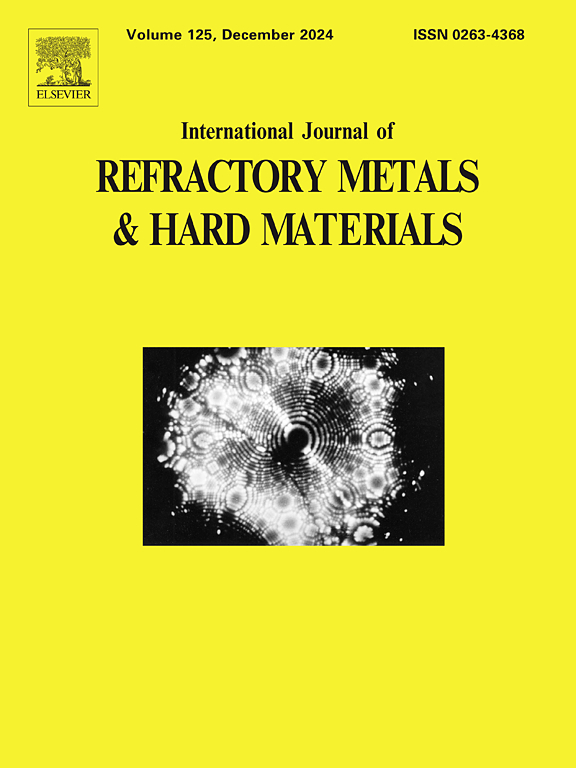Next-generation tungsten carbide cutting bits through cryogenic treatment technique for superior rock cutting performance for mining applications: An experimental study
IF 4.2
2区 材料科学
Q2 MATERIALS SCIENCE, MULTIDISCIPLINARY
International Journal of Refractory Metals & Hard Materials
Pub Date : 2024-10-16
DOI:10.1016/j.ijrmhm.2024.106923
引用次数: 0
Abstract
The mining sector seeks innovation to enhance operational efficiency and prolong cutting tool life. This research investigates the impact of cryogenic treatment (CT) for 12, 24, and 36 h on tungsten carbide cutting bits used in mine machineries, focusing on its effects on cutting force, energy consumption, and tool wear during lab-scale linear rock cutting. Microstructural analysis and hardness testing follow CT, revealing improvements in hardness, the formation of new compounds, and the presence of eta carbides. Analysis of linear rock cutting experiments shows that longer holding periods under CT lead to reduced cutting force, energy consumption, and tool wear. Comparing CT 24 to untreated bit at a cutting speed of 200 m/s, CT 24 demonstrates reduction in specific energy by 39.35 %, 41.13 %, and 29.39 % at depth of cut (DoC) of 2 mm, 4 mm, and 6 mm, respectively. Additionally, CT 24 exhibits significantly lower wear rates (79.24 %, 85.44 %, and 85.01 %) compared to UT bits at the same cutting speed. Microstructural analysis identifies multiple wear mechanisms in both treated and untreated worn tools. To optimize the cutting process for mining efficiency, grey relational analysis and Python-based non-dominant sorting are employed. Grey relational analysis identifies 24-h CT, a cutting speed of 200 m/s, and a 2 mm depth of cut as optimal. Non-dominant sorting suggests 24-h CT, a cutting speed of 200 m/s, and 2–4 mm cut depth for optimal results. Pareto solutions indicate specific energy ranging from 14.96 to 9.20 kWh/m3 and wear rates ranging from 0.33 to 0.39 × 10−4 cm3/cm. Insights from this study offer valuable guidance for the mining industry to enhance cutting tool efficiency and promote environmentally sustainable mining practices.
通过低温处理技术实现新一代碳化钨切削刃,为采矿应用提供卓越的岩石切削性能:实验研究
采矿业一直在寻求创新,以提高作业效率并延长切削工具的使用寿命。本研究调查了低温处理(CT)12、24 和 36 小时对矿山机械中使用的碳化钨切削刃的影响,重点是在实验室规模的线性岩石切削过程中对切削力、能耗和刀具磨损的影响。在 CT 之后进行了微观结构分析和硬度测试,结果显示硬度有所提高,形成了新的化合物,并出现了等碳化物。对线性岩石切割实验的分析表明,在 CT 下保持较长的时间可降低切割力、能耗和刀具磨损。在切削速度为 200 米/秒的条件下,将 CT 24 与未经处理的钻头进行比较,发现在切削深度(DoC)为 2 毫米、4 毫米和 6 毫米时,CT 24 的比能量分别降低了 39.35%、41.13% 和 29.39%。此外,在相同切削速度下,CT 24 的磨损率(79.24 %、85.44 % 和 85.01 %)明显低于UT 刀头。微结构分析确定了经过处理和未经处理的磨损工具的多种磨损机制。为了优化切削过程以提高采矿效率,采用了灰色关系分析和基于 Python 的非优势排序。灰色关系分析确定了 24 小时 CT、200 米/秒的切割速度和 2 毫米的切割深度为最佳。非优势排序建议 24 小时 CT、200 米/秒切割速度和 2-4 毫米切割深度为最佳结果。帕累托解决方案表明,比能量在 14.96 到 9.20 kWh/m3 之间,磨损率在 0.33 到 0.39 × 10-4 cm3/cm 之间。这项研究为采矿业提供了宝贵的指导,有助于提高切削工具的效率,促进环境可持续采矿实践。
本文章由计算机程序翻译,如有差异,请以英文原文为准。
求助全文
约1分钟内获得全文
求助全文
来源期刊
CiteScore
7.00
自引率
13.90%
发文量
236
审稿时长
35 days
期刊介绍:
The International Journal of Refractory Metals and Hard Materials (IJRMHM) publishes original research articles concerned with all aspects of refractory metals and hard materials. Refractory metals are defined as metals with melting points higher than 1800 °C. These are tungsten, molybdenum, chromium, tantalum, niobium, hafnium, and rhenium, as well as many compounds and alloys based thereupon. Hard materials that are included in the scope of this journal are defined as materials with hardness values higher than 1000 kg/mm2, primarily intended for applications as manufacturing tools or wear resistant components in mechanical systems. Thus they encompass carbides, nitrides and borides of metals, and related compounds. A special focus of this journal is put on the family of hardmetals, which is also known as cemented tungsten carbide, and cermets which are based on titanium carbide and carbonitrides with or without a metal binder. Ceramics and superhard materials including diamond and cubic boron nitride may also be accepted provided the subject material is presented as hard materials as defined above.

 求助内容:
求助内容: 应助结果提醒方式:
应助结果提醒方式:


